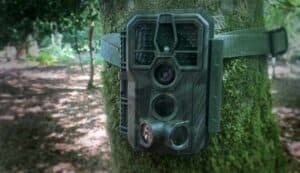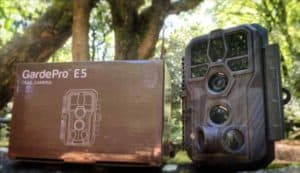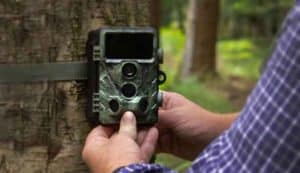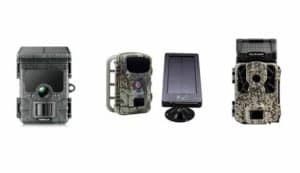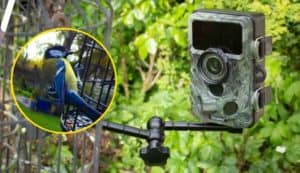This page may have Commerce Content. If you buy something from our posts, we may get a small share of the sale. Click here for more.
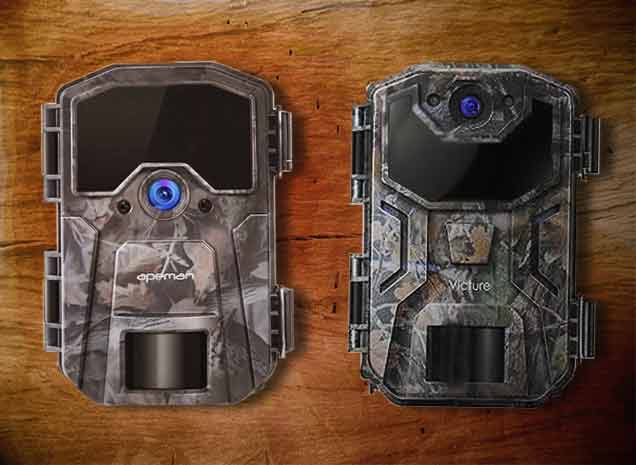

Editor & Article Writer for Outdoor Wilds
As an Amazon Associate I earn from qualifying purchases. Thank you for helping to support the site.
Trail Cameras Compared - Apeman 20MP vs Victure 20MP
The 2 trail cameras compared in this review are the Apeman H55 trail camera versus the Victure HC300 [1] trail camera.
Both trail cameras are aimed at the lower end of the budget trail camera market, having said that they do offer great performance for their outlay.
Read below to find out which camera performs better when used in real world set ups, recording pictures and video, plus an overall look at build quality, features and specification for each trail cam.
Apeman H55 20MP Trail Camera
The Apeman H55 is a clamshell design trail camera with the door opening to the left to access the control panel.
The front of the camera has a large black plastic cover for the infrared illuminators. The camera lens sits directly underneath and the PIR sensor is located at the base of the unit.
To open the clamshell you unclip the 2 clips on the right side of the case. The clips have a sturdy feel so they should live up to the IP66 rating. Water ingress shouldn’t be a problem over the course of a season as they close the case tightly.
At the base there’s a 1/4-20 thread insert for 3rd party mounts, the camera is supplied with a wall mount, plus a nylon tree strap.
The back of the camera housing has loops for a python lock, which is a nice addition.
Control Panel
Inside the camera the control panel has a 2 inch color LCD screen that has 5 buttons to scroll through the menu settings. It’s pretty intuitive and anyone used to trail cameras probably won’t even need to look at the manual.
The 3 way power switch has a middle test setting which is useful. This allows you to test the detection zone. A blue light on the front of the camera blinks when the PIR sensor is activated while in test mode, which makes it easier to check everything is working.
No products found.
Menu Settings
I’ll quickly touch on some of the standout features in the menu settings. The Apeman does have all the usual trail camera features such as time and date stamp, temperature stamp and so on.
The key settings for a trail camera are the modes. The H55 has 3 modes:
- Photo
- Video
- Photo & Video
Within each mode it’s possible to set the resolution for both video and still photos. Photo mode allows you to choose 1, 2 or 3 photos in a burst.Video length is adjustable from 5 seconds to 5 minutes. The camera also has a time lapse feature, if thats your type of thing.
PIR sensitivity is adjustable from low, medium to high which is a nice feature to have for a trail camera at this level.
Performance
Overall the Apeman H55 performed well. It matches the advertised detection range of 60 feet with no problem.
The daytime video and pictures are very good quality. You’re going to have to spend 3 times more on one of the top Browning trail cameras to see a marked improvement in image quality.
My only slight criticism is that images recorded when close to the IR illuminators do suffer from being over exposed. However this is a problem all trail cameras have expect the top of the range trail cams. They allow you to lower the infrared LEDs power for close up detection sites such as near a food plot.
It’s worth noting the LEDS are the Black flash variety, so there shouldn’t be an issue with scaring game animals or the camera being spotted at night by humans.
Batteries
A quick mention in regards to batteries. The 8 x AA batteries were only 1/4 used after a full 32GB SD with both pictures and video. So I’d say that battery life is way better than average.
Summary
The Apeman is a good solid performing trail camera for the money. The detection circuit is good, and the chances of false triggers is low.
The picture quality is very good for a trail camera in this price range. If you want really high quality pictures then you will have to look at spending a lot more.
Overall, if you’re looking for a trail camera that will perform well throughout the season on public land the take a look at the Apeman H55, it may just be the ideal trail camera.
Victure HC300 20MP Trail Camera
The Victure comes with exactly the same accessories as the Apeman does. In the box is a nylon tree strap, a metal wall mount with fixings, plus a USB cable.
The camera is, again a clamshell design and looks and feels almost identical to the Apeman. The case is IP66 rated, which means the case is dust tight and strong water jet sealed.
The underside of the camera has a 1/4-20 thread insert, plus a 6 volt external power jack.
Control Panel
The layout is identical to the Apeman. I always like trail cameras with the LCD screen on the back of the camera case. This means you can see exactly where the camera is aiming.
Included is the test mode setting on the 3 stage power switch. As I touched on earlier in the Apeman review, its a great feature to have.
No products found.
Menu Settings
Well; Again the menu settings are exactly the same as the Apeman. Both manufactures have used the same electronics it seems, which makes it interesting to see how the compare out in the field.
Performance
Summary
Out of the 2 trail cameras on test here, there’s very little difference between them. The Victure has the better night-time images as mentioned above and the overall package just seemed to edge it in terms of quality compared to the Apeman trail camera.
I’d suggest buying both to test for yourself if you’re planning on buying in bulk to see which one you prefer first off and then buying the winner out of your personal test comparison.
Popular Posts





